What to Use Instead of a Rolling Pin
When you're in a pinch without a rolling pin, several household items can come to the rescue. A wine bottle, glass drinking cup, or smooth cylindrical can of food work well for flattening dough. For a more DIY approach, try a clean PVC pipe or wooden dowel from the hardware store. Your own hands and palms can be effective too, especially for smaller batches. A firm water bottle or thermos can also do the trick. Remember to clean any substitute thoroughly before use and apply even pressure for consistent results. These alternatives offer practical solutions, but there's more to explore in perfecting your dough-rolling technique.
This post may contain affiliate links. If you make a purchase through these links, I may earn a commission at no additional cost to you. Additionally, portions of this post may be generated using artificial intelligence (AI) technology. While we strive for accuracy, please be aware that AI-generated content may not always be perfect and should be fact-checked when necessary.
The Spatula Scoops
- A wine bottle serves as an effective rolling pin substitute due to its cylindrical shape and weight.
- Glass drinking cups offer a smooth surface for rolling dough and are readily available in most kitchens.
- Canned goods provide consistent pressure for flattening various types of dough and are easily cleaned.
- Clean hands and palms can be used to press and shape dough when no tools are available.
- PVC pipes or wooden dowels from hardware stores can be customized for length and diameter as rolling pin alternatives.
Wine Bottle

With a wine bottle, you've got a handy rolling pin substitute right in your kitchen. This everyday item can effectively flatten dough for various baking projects. To use it, guarantee the bottle is clean and dry, then remove the label for a smooth surface. You'll find that the cylindrical shape and weight of the bottle mimic a traditional rolling pin quite well. For those who bake frequently, investing in a dedicated tool like a French Rolling Pin would provide extra durability and control when working with different types of dough.
When using a wine bottle as a rolling pin, you'll want to apply even pressure as you roll. Start from the center of your dough and work outwards, rotating the dough occasionally for uniform thickness. The bottle's natural weight helps in achieving consistent results, but you may need to apply additional pressure for stiffer doughs.
One advantage of using a wine bottle is its versatility in size. A standard 750ml bottle works well for most tasks, while larger formats like magnums can cover more surface area. However, be cautious with delicate pastries, as the glass may not provide the same level of control as a purpose-built rolling pin. Always handle the bottle carefully to avoid breakage and potential injury.
Glass Drinking Cup
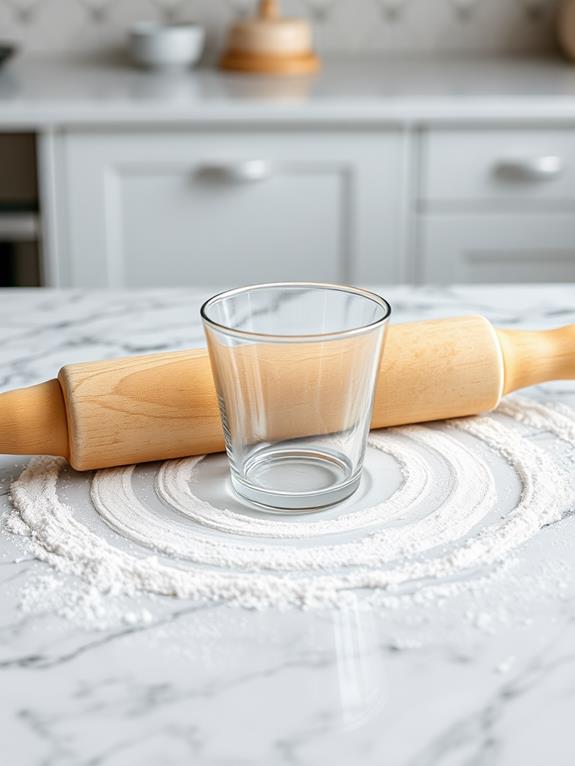
When you're in a pinch, a glass drinking cup can serve as an effective rolling pin substitute. Its smooth cylindrical surface allows for even pressure distribution when rolling out dough, while its readily available nature means you'll likely have one on hand in your kitchen. Additionally, using a glass cup, such as those from the Pyrex measuring cup set, guarantees you have a durable and safe option since glass does not absorb food odors or stains. After use, you'll find that the non-porous glass is easy to clean, guaranteeing your makeshift rolling pin is always ready for your next baking adventure.
Smooth Cylindrical Surface
A smooth cylindrical surface like a glass drinking cup can serve as an excellent substitute for a rolling pin. You'll find this method particularly useful when you're in a pinch and need to flatten dough quickly. To use a glass cup effectively, confirm it's clean and dry before starting. Place your dough on a lightly floured surface, then gently press the side of the cup against it, rolling back and forth with even pressure.
This technique works well for various types of dough, including cookie, pie crust, and pizza. You'll want to pay attention to the cup's size; a larger diameter will cover more area, while a smaller one allows for more precise control. As you roll, rotate the dough occasionally to maintain an even thickness. If you're concerned about sticking, you can cover the dough with a sheet of parchment paper before rolling.
Easy to Clean
Cleanliness is a key advantage when using a glass drinking cup as a rolling pin substitute. You'll find that its smooth, non-porous surface is incredibly easy to clean, making it a hygienic option for your baking needs. Unlike wooden rolling pins that can absorb moisture and harbor bacteria, glass is resistant to stains and odors.
After you've finished rolling out your dough, simply rinse the glass cup with warm, soapy water. For stubborn residue, you can use a soft sponge or cloth to gently scrub the surface without fear of scratching. If you're dealing with particularly sticky substances, soaking the glass in warm water for a few minutes will make cleanup a breeze. Once clean, dry the cup thoroughly with a lint-free towel to prevent water spots.
An added benefit of using a glass cup is its dishwasher-safe nature. You can place it in your dishwasher alongside your other kitchenware, ensuring a thorough sanitization. This ease of cleaning not only saves you time but also contributes to maintaining a food-safe environment in your kitchen, which is essential for both home bakers and professional chefs alike.
Readily Available Option
In almost every kitchen, you'll find a glass drinking cup ready to serve as an impromptu rolling pin. This readily available option is perfect when you're in a pinch and need to flatten dough or crush ingredients. The smooth surface and cylindrical shape of a glass cup make it an ideal substitute for a traditional rolling pin.
To use a glass cup as a rolling pin, simply clean it thoroughly and dry it completely. Then, place your dough on a floured surface and begin rolling the cup back and forth, applying gentle pressure. The weight of the glass provides enough force to flatten the dough evenly. For best results, use a cup with straight sides and a smooth bottom.
This method works well for various types of dough, including cookie dough, pie crust, and even pizza dough. It's particularly useful for smaller batches or when working in tight spaces. While it may not be as efficient as a professional rolling pin for large-scale baking, a glass cup is an excellent alternative for occasional use or when traveling. Remember to handle the glass carefully to avoid breakage and guarantee food safety.
Canned Goods

Canned goods can be an excellent substitute for a rolling pin, thanks to their cylindrical shape and variety of sizes. You'll find that cans offer a smooth, even surface for rolling out dough, making them a practical option in the kitchen similar to how specific techniques can enhance vegan cooking exploring unfamiliar ingredients. You can choose from different diameters to suit your needs. After use, simply wipe the can clean or run it through the dishwasher, making it a convenient and hygienic option for your baking tasks.
Cylindrical Shape Advantage
For an effective rolling pin substitute, search no further than your pantry. Canned goods, with their cylindrical shape, offer a distinct advantage when it comes to flattening dough. The uniform surface of a can provides consistent pressure, allowing you to achieve an even thickness across your pastry or cookie dough. You'll find that the weight of the can aids in the rolling process, requiring less effort on your part.
When using a canned good as a rolling pin alternative, consider these key points:
- Choose a can with a smooth, seamless surface to prevent imprinting on your dough
- Opt for larger cans, such as those for vegetables or soups, for better coverage
- Clean the can thoroughly before use to maintain food safety standards
- Wrap the can in plastic wrap or wax paper for easier cleanup and improved hygienic practices
The cylindrical shape of canned goods mimics the functionality of a traditional rolling pin, making them a commendable substitute. You'll appreciate the versatility of this common household item, as it can help you roll out various types of dough with ease. Remember to apply even pressure and rotate the can as you work for best results.
Variety of Sizes
One of the greatest advantages of using canned goods as rolling pin substitutes is the variety of sizes available in your pantry. You'll find an array of options, from small tomato paste cans to large soup cans, each serving a unique purpose in your baking endeavors. This diversity allows you to choose the most appropriate size for your specific dough-rolling needs.
For smaller tasks, like flattening cookie dough or creating mini pie crusts, a petite can of tuna or vegetables works perfectly. When you're tackling larger projects, such as rolling out pizza dough or a pie crust for a full-sized pie, opt for a heftier can of beans or crushed tomatoes. The varying diameters and lengths of canned goods enable you to achieve different thicknesses and shapes in your dough. This flexibility is particularly useful when you're working with recipes that require precise measurements or when you're aiming for a specific texture in your baked goods. By leveraging the assortment of canned goods in your kitchen, you can effectively replicate the functionality of various rolling pin sizes without investing in multiple specialized tools.
Easy to Clean
Along with their versatility, canned goods excel as rolling pin substitutes due to their ease of cleaning. After you've finished using a can for flattening dough, simply wipe it down with a damp cloth or rinse it under warm water. There's no need to worry about flour getting stuck in crevices or dough remnants clinging to hard-to-reach areas, as you might with a traditional rolling pin.
To maximize the cleanliness and efficiency of your canned good rolling pin substitute, consider these tips:
- Choose smooth-sided cans without ridges or embossed labels
- Remove paper labels before use to prevent them from getting wet or sticky
- Opt for cans with pull-tab lids to avoid sharp edges from can openers
- Sanitize the can before and after use with a food-safe disinfectant
The smooth, non-porous surface of most cans makes them resistant to bacterial growth, ensuring a hygienic tool for your baking needs. You'll appreciate the simplicity of this kitchen hack, especially when you're short on time or storage space. Remember, while canned goods are convenient alternatives, they may not provide the same level of control as a purpose-built rolling pin for more intricate pastry work.
PVC Pipe

DIY enthusiasts and resourceful bakers can turn to PVC pipe as an unexpected yet effective rolling pin substitute. This readily available material offers several advantages for your dough-rolling needs. You'll find PVC pipe at most hardware stores, typically in various diameters and lengths. For ideal results, choose a pipe with a smooth exterior surface and a diameter of about 2 inches.
Before using your PVC pipe rolling pin, make certain it's thoroughly cleaned and dried. You may want to sand the edges slightly to prevent any rough spots from catching on your dough. When rolling, you'll notice the pipe's uniform shape creates an even thickness across your pastry. Its lightweight nature makes it easy to maneuver, reducing fatigue during extended baking sessions.
One notable benefit of using PVC pipe is its versatility. You can cut it to your desired length, creating a custom-sized rolling pin that fits your workspace perfectly. Additionally, PVC is non-porous, which means it won't absorb odors or flavors from your dough. This characteristic makes it an excellent choice for rolling out various types of pastry without the risk of flavor transfer.
Wooden Dowel

A sturdy wooden dowel serves as an excellent alternative to a traditional rolling pin. You'll find these cylindrical wooden rods at most hardware stores, typically in various diameters and lengths. When selecting a dowel for rolling dough, opt for one that's about 1.5 to 2 inches in diameter and 18 to 24 inches long. This size provides ample surface area and leverage for effective dough manipulation.
Before using your wooden dowel, make sure it's food-safe by sanding any rough spots and applying a food-grade mineral oil. This treatment helps prevent the wood from absorbing moisture and protects against bacterial growth. When rolling, use the same techniques you'd employ with a traditional rolling pin, applying even pressure and rotating the dough as needed.
Here are four benefits of using a wooden dowel:
- Cost-effective alternative to specialized kitchen tools
- Versatile for various dough thicknesses
- Easy to clean and maintain
- Provides excellent control for precise rolling
Remember to store your wooden dowel in a dry place to prevent warping or cracking. With proper care, this simple tool can become an invaluable asset in your kitchen, helping you create perfectly rolled dough for pies, pastries, and more.
Hands and Palms
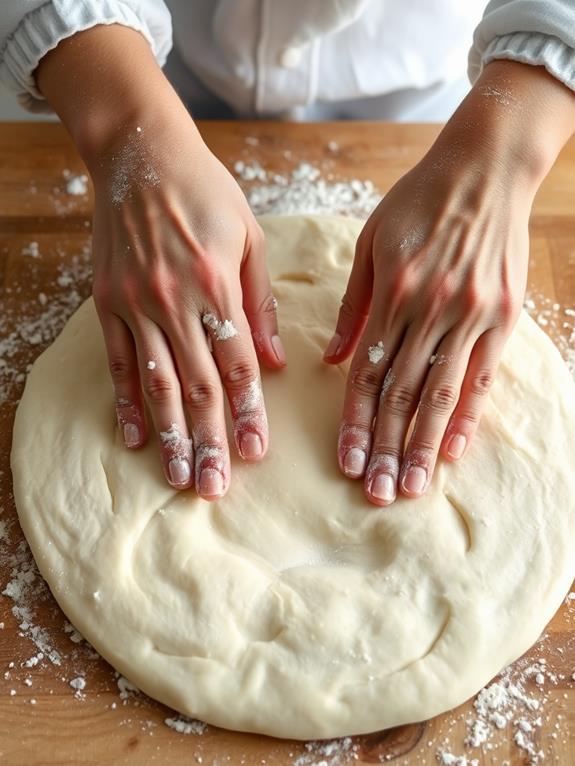
Perhaps the most readily available tool for rolling dough is your own hands and palms. You'll find this method particularly useful when you're in a pinch or working with small batches of dough. To use this technique effectively, first, make certain your hands are clean and cool. Dough can be sensitive to heat, so if your hands are warm, rinse them under cold water before starting.
Begin by pressing the dough flat with your palms, then use your fingertips to gently push it outward from the center. As you work, rotate the dough to maintain an even thickness. For larger pieces, you can use the heel of your hand to apply more pressure. Remember to flour your work surface and hands to prevent sticking.
Here's a quick reference table for hand-rolling techniques:
| Technique | Best For | Tips |
|---|---|---|
| Fingertip Press | Delicate doughs | Use light pressure |
| Palm Press | Sturdier doughs | Apply even force |
| Heel of Hand | Large surfaces | Roll from center out |
| Knuckle Roll | Thin crusts | Keep fingers curled |
While this method requires more effort than using a rolling pin, it offers precise control and can help you develop a better feel for your dough's consistency.
Firm Water Bottle
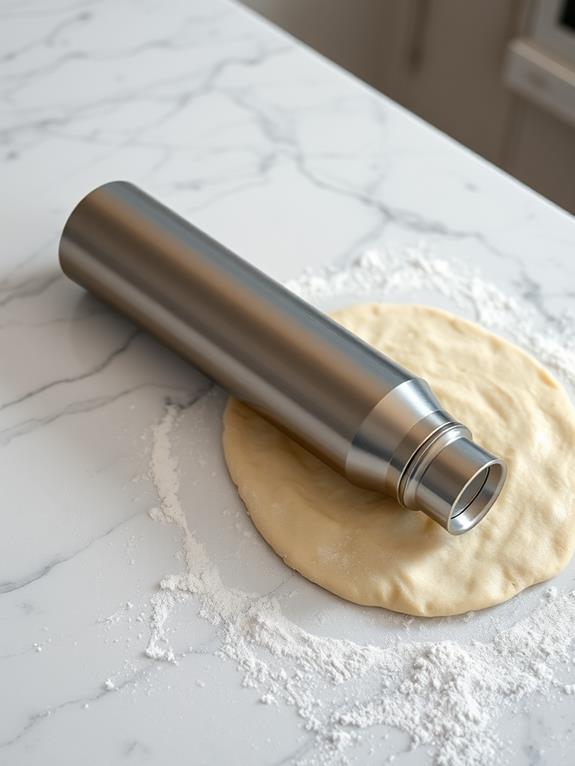
Filled with water and sealed tightly, a firm plastic water bottle can serve as an excellent makeshift rolling pin. Its smooth surface and cylindrical shape allow you to apply even pressure across dough, creating a consistent thickness. You'll find this method particularly useful when traveling or in situations where you don't have access to traditional kitchen tools.
To use a water bottle effectively as a rolling pin:
- Choose a bottle with a smooth, uniform surface
- Fill it completely with water to guarantee rigidity
- Seal tightly to prevent leaks
- Clean the exterior thoroughly before use
When rolling out dough with a water bottle, you'll want to use a back-and-forth motion, applying gentle pressure. This technique helps distribute the dough evenly and prevents sticking. Remember to flour your work surface and the bottle to minimize adhesion.
While not as precise as a professional rolling pin, a water bottle can effectively flatten cookie dough, pie crusts, and even pizza bases. It's a versatile tool that demonstrates how everyday objects can be repurposed for culinary tasks. By understanding this alternative method, you're expanding your repertoire of kitchen hacks and improving your ability to adapt in various cooking scenarios.
Thermos or Travel Mug
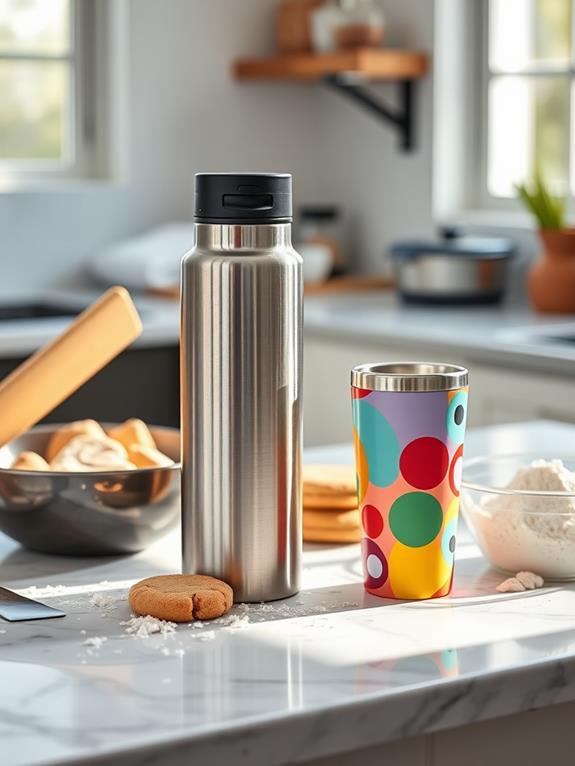
Moving from water bottles to another common household item, you'll find that a thermos or travel mug can be an effective substitute for a rolling pin. These cylindrical containers, typically used for keeping beverages hot or cold, can double as makeshift rolling tools in your kitchen. When selecting a thermos or travel mug for this purpose, opt for one with a smooth, even surface to guarantee uniform pressure on your dough.
To use this alternative, make sure the container is clean and dry. Remove any detachable parts, such as lids or straps. Place your dough on a lightly floured surface and position the thermos or travel mug horizontally on top. Apply gentle, even pressure as you roll it back and forth, rotating the dough occasionally to maintain an even thickness. The thermal properties of these containers can be advantageous, as they won't warm up as quickly as your hands, helping to keep the dough cool during the rolling process. This method is particularly useful for rolling out cookie dough, pie crusts, or flatbreads. Remember to wash your thermos or travel mug thoroughly after use to remove any flour or dough residue.
Smooth Vase
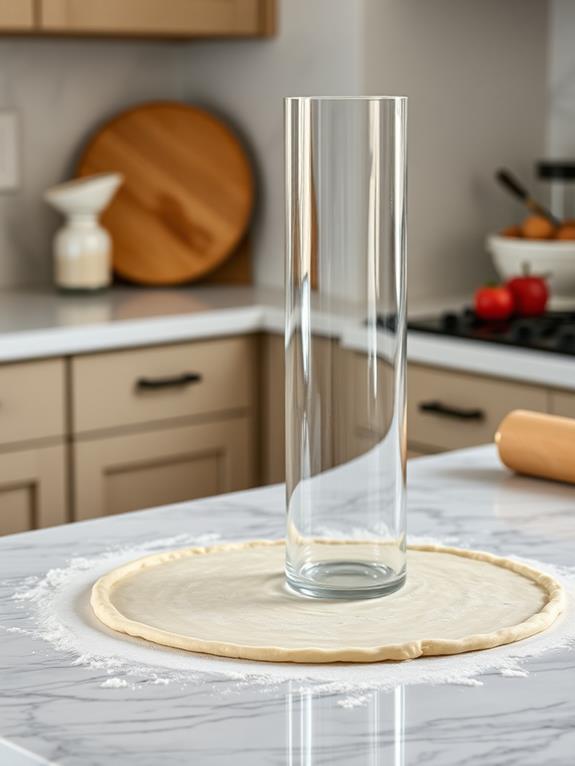
A smooth vase can step in as an unexpected but effective rolling pin substitute. When you're in a pinch and need to flatten dough, this household item can save the day. Look for a vase with a cylindrical shape and a smooth surface, free from any decorative patterns or textures. Before using, make certain to clean and dry the vase thoroughly to maintain food safety standards.
To use a smooth vase as a rolling pin:
- Dust your work surface and the vase with flour to prevent sticking
- Place your dough on the floured surface and position the vase horizontally
- Apply gentle, even pressure as you roll the vase back and forth
- Rotate the dough occasionally to guarantee uniform thickness
The vase's weight can work to your advantage, helping to flatten the dough with less effort. However, be cautious not to apply too much pressure, as the glass may be more fragile than a traditional rolling pin. This method works well for various dough types, including cookie dough, pie crusts, and even pizza bases. While not as ergonomic as a proper rolling pin, a smooth vase can be a viable alternative when you're in a bind.
Frequently Asked Questions
Can I Use a Rolling Pin Substitute for All Types of Dough?
You can use rolling pin substitutes for most types of dough, but it's not always ideal. For delicate pastries, a wine bottle or smooth glass might work well. For sturdier doughs like pizza or bread, you could use a clean can or even your hands. However, some specialized doughs, like phyllo or puff pastry, require precise thickness control that's hard to achieve without a proper rolling pin. Always consider the dough's texture and your desired outcome when choosing a substitute.
How Do I Clean Unconventional Rolling Tools After Use?
When you're in a pickle with unconventional rolling tools, cleaning them is key. First, remove any dough remnants with a spatula or brush. For wooden items, like wine bottles, wipe them down with a damp cloth and dry thoroughly. Metal objects can be washed with soap and water. Plastic containers should be cleaned according to their care instructions. Always verify your makeshift rolling pin is completely dry before storing to prevent mold or bacteria growth. Remember, proper cleaning extends the life of your kitchen tools.
Are There Any Safety Concerns When Using Alternative Rolling Pin Methods?
When using alternative rolling pin methods, you'll want to take into account a few safety concerns. First, verify any makeshift tools are clean and food-safe. Be cautious with glass bottles, as they can break under pressure. If using canned goods, check for sharp edges. When employing rolling techniques without tools, like using your hands, be mindful of hygiene. Always work on a stable surface to prevent accidents. Finally, if using unconventional methods, take care not to overwork or damage your dough.
What's the Best Substitute for Rolling Out Delicate Pastry Dough?
For delicate pastry dough, you'll want a gentle touch. Your best substitute is a chilled wine bottle. It's smooth, heavy, and maintains a cool temperature, which is essential for pastry. Simply clean the bottle, remove the label, and use it like a rolling pin. Alternatively, you can use a drinking glass or a smooth cylindrical container. Remember to work quickly and handle the dough minimally to avoid overworking it and developing gluten, which can make your pastry tough.
Can I Achieve the Same Thickness Consistency With Makeshift Rolling Tools?
You can achieve consistent thickness with makeshift rolling tools, but it'll take some practice. Wine bottles, cans, and even PVC pipes can work, though they may not be as precise as a rolling pin. You'll need to apply even pressure and roll steadily. For delicate pastry, try using a smooth glass bottle or a clean, unopened can. Remember to flour your surface well and work gently to avoid tearing the dough. With patience, you'll get the hang of it.





